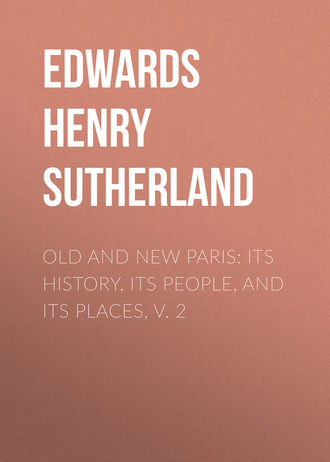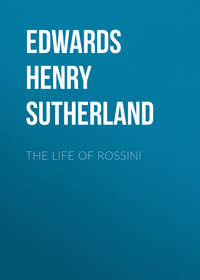 полная версия
полная версияOld and New Paris: Its History, Its People, and Its Places, v. 2
Again and again the church of Saint-Germain-des-Prés has been restored: as in 1644, in 1820, at the time of the Restoration, and finally under Napoleon III. The choir preserves intact the style of the twelfth century. Among the tombs may be seen the tomb of King Casimir of Poland, who, after becoming a monk, was made abbé of Saint-Germain, and died holding that office in 1672. In a chapel on the opposite side of the church is the tomb of Olivier and Louis de Castellan, who fell in the service of Louis XIV., and a little further on the chapel of the Douglases, many of whom served in the Scottish Guard. Here too are the remains of Boileau and Descartes. The sacred pictures around the choir and the nave are the work of Hippolyte Flandrin, the most celebrated among the pupils of Ingrès, who died before completing his work, and to whom, in the church he loved to decorate, a monument in white marble has been erected, surmounted by his bust.
It must not be forgotten that during the greater part of its history the ancient church of Saint-Germain-des-Prés was outside Paris, which gradually grew towards it and at last surrounded it. On the 2nd of November, 1589, Henry IV., besieging Paris, went up the convent tower, accompanied by a single monk, to examine the situation of the town. He is said to have afterwards gone round the walls of the cloister. But he did not enter the church, and he withdrew without uttering one single word.
Saint-Germain-des-Prés was at one time known as the Church of the Three Steeples. These were destroyed in 1822 under Louis XVIII. as a measure of economy, since it would otherwise have been necessary to restore them.
The monastery of Saint-Germain-des-Prés used to contain a library, which was at that time the largest in Paris, and the only one that was open to the public. Begun by Father du Breul, author of the “Antiquities of Paris,” it was augmented through legacies from the physician Noel Vaillant, the Abbé Baudran, the Abbé Jean d’Estrées, the Abbé Renaudot, the Chancellor Séguier, the Cardinal Gesvres, the Councillor of State De Harlay, and others, who, dying, left their libraries to Saint-Germain-des-Prés. The collection included 100,000 printed volumes, and 20,000 manuscripts, all of which found their way to the National Library, where they are now preserved. Close to Saint-Germain-des-Prés, and between this church and that of Saint-Sulpice, was held the famous market or fair of Saint-Germain. In the fifteenth century the Saint-Germain fair used indeed to be held in the garden of the presbytery of Saint-Sulpice. Antiquaries are not quite agreed as to the antiquity of Saint-Sulpice; not, that is to say, as to the precise date, undoubtedly a remote one, of its origin. A tombstone of the tenth century, found in 1724, when, during the restoration of the church, the foundations had to be examined, showed that the cemetery, attached to which there would naturally be a chapel, had existed from the earliest period. A new chapel or church is supposed to have been built in place of the more ancient one during the thirteenth or fourteenth centuries. A nave was added to it under Francis I., and three chapels in 1614. In 1643 a council was held under the presidency of the Prince de Condé, at which it was determined to rebuild the church, which was too small for the requirements of the neighbourhood and, above all, was falling into ruins. The first stone of the new church was laid by Anne of Austria in 1646. The building operations were, however, discontinued in 1678; and it was not until 1721 that – thanks to a lottery for which permission was given by Louis XV. – enough money was found to enable the architect, Servandoni, to complete the work. The architecture of Saint-Sulpice has been severely criticised, especially by Victor Hugo, who compared the lofty towers (one, by the way, much loftier than the other) to clarinets. The church of Saint-Sulpice is remarkable, among its various treasures, for a magnificent balustrade enclosing the choir, and the statues of the twelve apostles by Bouchardon which surround it. The pulpit given in 1788 by the Duc de Richelieu is surmounted by an admirable group sculptured in wood: “Charity surrounded by her children.” Very curious is the obelisk in white marble, more than eight metres high, constructed in the most scientific manner by Sully and Lemonnier, in 1773, to determine the occurrence of the spring equinox and of Easter Day. The two enormous shells which hold at the entrance to the church the holy water were gifts from the Republic of Venice to Francis I.
The chapels of the nave and of the choir, decorated by the most celebrated artists of this century, present admirable specimens of religious painting. Eugène Delacroix is represented in the chapel of the Holy Angels by two mural pictures and a painted ceiling, all instinct with his fiery genius. The Triumph of Saint Michael, Heliodorus Beaten with Rods, and Jacob Wrestling with the Angel, are the subjects. The artists who have painted the various chapels are too numerous to mention. The organ-loft rests on composite columns of a grandiose character, the work of Servandoni, and the organ is worthy of the loft built for its reception. Reconstructed in 1861 by Cavaillé-Coll, this majestic instrument with its ten octaves possesses 5 complete key-boards, 118 registers, 20 pedals, and about 7,000 pipes. The organ of Saint-Sulpice is said to be the largest in Europe, and on Sundays and holidays the congregation is never without a certain number of dilettanti who have come to hear the gigantic instrument speak beneath the eloquent fingers of M. Widor, whose duties as organist have not prevented him from writing the music of a ballet, “La Korrigane,” for the Opéra, and of a lyric work, “Maître Ambros,” for the Opéra Comique. Widor, the organist of Saint-Sulpice, composing ballet-music reminds one of the still more violent relief sought by Hervé, who passed from the organ-loft to the stage of the Folies Dramatiques with his burlesque operettas of “L’Œil Crevé” and “Le Petit Faust.” The hero of M. Hervé’s operatic vaudeville “Nitouche” is perhaps a typical personage in the musical world of Paris. He also is an organist by profession, a composer of light opera by aspiration; and he gets into sad trouble by teaching frivolous airs to the pupils of the convent school where he is employed to play psalms and hymns.
Strangely enough, by what hazard can scarcely be said, in the organ-loft of Saint-Sulpice is to be found the harpsichord of Marie Antoinette. What a contrast between the delicate sounds of this feeble instrument and the thunder of its colossal neighbour!
The church of Saint-Sulpice, renamed in 1793, at the height of the Revolution, Temple of Victory, was the scene on the 9th of November, 1799, of a banquet, at which General Bonaparte presided. In 1802 it was restored to public worship. The existing church rests on an immense crypt, in which the architects have respected the pillars of the original church. In this subterranean church, which is adorned with statues of Saint Paul and Saint John the Evangelist by Pradier, the catechism is taught and conferences are held. The plan of Servandoni comprised a space in front of the church, enclosed by symmetrical façades, the model of which may be seen in the south-east corner of the square, between the Rue des Canettes and the Rue Saint-Sulpice. This part of the architect’s project was, however, abandoned.
Completed in virtue of a decree of the year 1811, and planted with trees in 1838, the Place Saint-Sulpice has been adorned since 1847 with a monumental fountain constructed by Visconti in place of an older one removed to the Marché Saint-Germain. The four statues which form part of the design, in the midst of three concentric basins, represent Bossuet, Fénélon, Massillon, and Fléchier. Beneath the eyes of the four preachers in bronze a flower-market is held twice a week.
Quitting the Place Saint-Sulpice by the Rue Bonaparte, passing before Saint-Germain-des-Prés, and crossing the Rue Jacob, we reach the section of the Rue Bonaparte which was originally called Rue des Petits Augustins, and which stands on what, until it was filled up, was the bed of the Little Seine.
CHAPTER XXVI.
PRINTING IN PARIS – THE CENSORSHIP
Rue Visconti – Historical Buildings – The National School of Roads and Bridges – The Introduction of Printing into Paris – The First Printing Establishments – The CensorshipSTARTING once more from the Place Saint-Sulpice, and proceeding by the Rue Bonaparte across the Rue Jacob to the Rue des Petits Augustins, we come to the ancient Rue des Marais, a narrow street opened in 1540 between the Rue des Petits Augustins and the Rue de Seine. It is now called the Rue Visconti, and contains at least one house which is worth a moment’s attention – the Hôtel de Ranes, No. 21. Here Nicholas d’Argouges, Marquis de Ranes, who built the house, was killed in 1678. Jean Racine came to live in the building as lodger in 1692; and here was born in that same year the last of his children, Louis Racine, author of that much-esteemed poem, “La Réligion.” It was here, too, that the immortal author of “Phèdre” expired on the 21st of April, 1699. Other theatrical associations are connected with this house.
Here, moreover, Adrienne Lecouvreur, the celebrated actress, died on the 20th of March, 1730, and, the last rites of the Church being refused, was carried away the same night in a hackney-coach by Voltaire and a friend of Marshal Saxe who had always been devoted to her. She was buried on the banks of the Seine at a point beyond the Palais Bourbon, which it is no longer possible to discover. The place was marked at the time by a simple memorial, which from malice or through neglect and the natural ravages of time, was destined soon to disappear.
Later on this same house was inhabited by Mdlle. Clairon, who only quitted it when she resigned her engagement at the Comédie Française.
At No. 17 in this interesting Rue Visconti existed in 1825 the printing-office founded by Honoré de Balzac. But the greatest novelist of France met with no greater success as a printer than the greatest novelist of England obtained as a publisher. Balzac, like Scott, contracted debts in his business enterprise which weighed heavily upon him and, compelling him to the severest literary labour, shortened his existence. It was to pay his debts that Balzac condemned himself to that perpetual work, those prolonged night-watches, which developed in him, robust as he was in his early days, the germs of that hypertrophy of the heart from which he died. In the street of Les Petits Augustins stood a convent, founded in the midst of a garden to fulfil a vow made by Queen Margaret at the Château d’Usson.
The convent was turned by the Constituent Assembly in 1790 into a depòt for monuments and ruins of monuments whose preservation was desirable in the interest of history or of art. Alexandre Lenoir, who had proposed the formation of this museum, was appointed its superintendent. In carrying out his seemingly peaceful work he found himself on one occasion in danger of his life, for some madman wounded him with a bayonet as he was protecting by main force the monument of Cardinal de Richelieu which a number of fanatics wished to destroy. The precious collection brought together by Lenoir was inaugurated in 1795 under the title of the National Museum of French Monuments.
An imperial decree of the 24th of February, 1811, ordered the creation of a School of Fine Arts, which was to contain common rooms for the lectures and separate studios for the different professors with their pupils. By order of the restored Louis XVIII., in April, 1816, the School of Fine Arts, with which no progress had been made under Napoleon, was to be completed. Then, however, it occurred to the king that it would be unbecoming to turn out from what had been considered their last resting-place so many statues, busts, tombs, and other monuments. Churches were now requested to claim the ornaments of which, under the Revolution, they had been despoiled, the different communes to take back the arms and other insignia which had been torn by fanatical revolutionists from their walls, while the great historic families were assured that they were now at liberty to resume possession of their ancestral sepulchres. But these permissions and appeals were for the most part in vain. Meanwhile the mausoleums of the kings and princes of France were removed to Saint-Denis, while many other monuments were placed in the museums of Paris and Versailles.
It was now possible to proceed with the School of Fine Arts, and the first stone of the building was laid on the 3rd of May, 1820. The original plan, drawn up by the architect Debret, was much amplified, under the reign of Louis Philippe, by M. Dauban, who finished it in 1838 – at least in its essential parts. New buildings were added under the Second Empire between the years 1860 and 1862. The National Special School of Fine Arts (such is its official title) furnishes instruction in drawing, painting, sculpture, architecture, and every kind of engraving to French students aged not less than fifteen nor more than thirty, and even to foreigners who have obtained due authorisation from the Ministry of Fine Arts.
The School of Fine Arts occupies a palace worthy of the institution. Its general plan is simple in the extreme. Through the gate of its entrance, adorned with two colossal busts of Puget and of Poussin, may be seen a square courtyard whose walls are covered with admirable monuments, for the most part from the above-mentioned Musée des Monuments Français. This courtyard is separated from the principal one into which it leads by a sort of triumphal arch, dating from the year 1500. It was brought from the Château de Gaillon and reconstructed stone by stone. At the end of the principal courtyard is the grand façade due to M. Dauban, composed of two storeys of arcades separated by Corinthian pilasters. The vestibule of the ground floor contains fragments of ancient marbles, casts from the temple of Egina and of the Parthenon, clever, curious copies of paintings discovered at Pompeii, etc. The vestibule leads to a magnificent collection of plaster casts from the most celebrated ancient works of antiquity, including two columns from the temple of Jupiter Stator, and one of the corner-pieces of the Parthenon. In the floor above are to be seen the fifty-two copies of the Loggie of Raphael, executed in 1836 by the brothers Balze, under the direction of the illustrious Ingrès, who had made Raphael the study of his life. The same storey contains, among other celebrated works, the hemicycle, painted by Paul Delaroche, representing the principal masters of every age and of every school, grouped around Ictinus and Phidias, the painter and sculptor of the Parthenon. This masterpiece has been popularised, in engraving, by Henriquel Dupont, one of the most regretted professors of the School of Fine Arts. It is impossible to leave the School of Fine Arts without casting a glance on the mansions which either surround or adjoin it, from the beginning of the Quai Malaquais, at the corner of the Rue de Seine, to the Rue des Saint-Pères, all of which enjoy magnificent views of the Seine, the Louvre, and the Tuileries. They have all the same origin, having been built during the first years of the seventeenth century on the property of Queen Margaret. No. 1 on the Quai Malaquais, with its two meagre wings on each side of a feeble body, was the mansion of Aubespine; and it was there that the celebrated archæologist, Visconti, died in 1818. No. 5 was at one time occupied by Marshal Saxe.
The noble house, with its façade of red bricks and white stone – No. 9, at the other corner of the Rue Bonaparte – was the Hôtel Loménie de Brienne et Loutrec. Nos. 11 and 13, now replaced by the exhibition-rooms of the School of Fine Arts, were built by Cardinal Mazarin for his niece Marianne Martinozzi, left a widow in 1666 by the death of Prince de Conti, younger brother of the great Condé. Originally Hôtel Conti, it passed from Conti’s widow, who received the Hôtel Guénégaud in exchange, into the hands successively of the Créquis, the Tremvilles, the Lauzuns, and three or four other aristocratic families, to become subsequently the office of the general police.
The right corner of the Rue des Saints-Pères and of the Rue de Lille is occupied by a new building with windows few and far between, and gates which might be those of a fortress. This is the special school of living Oriental languages founded by Louis XIV., reorganised in 1795 and again in 1869 and 1871. For many years it was an annex of the National Library, where it occupied an old building in the New Street of the Little Fields. For some few years past it has been established at No. 2 in the Rue de Lille. The languages taught in this institution comprise literary Arabic, the Arabic of ordinary conversation, Armenian, Persian, Turkish, Annamite, Chinese, modern Greek, Japanese, Malay, Russian, Roumanian, Hindostanee, and the Tamul languages. Attached to the professors are teachers born in the different and distant lands whose languages are studied in this school.
At the opposite corner (Rue de Lille, No. 1) is a magnificent mansion which now belongs to the publishing house of Garnier Brothers. During the period immediately before the French Revolution the stables of the Countess of Artois were here established. Throughout the First Empire it was occupied by Count Réal, entrusted with the first department of the Ministry of General Police, in which there were altogether fifty-one departments. From 1821 to 1849 it was the office of the first military division.
On the right side of the Rue des Saints-Pères, opposite the former entrance to the hospital of La Charité, is the National School of Roads and Bridges – until 1788 the Hôtel Fleury; from 1824 to 1830 the Ministry of Worship; and throughout the reign of Louis Philippe the Ministry of Public Works.
The National School of Roads and Bridges, created by Louis XV. in 1741, and developed by different decrees of the two empires, has for its special object the education of young men quitting the Polytechnic School after good examinations as civil engineers. It is placed beneath the authority of the Minister of Public Works, and directed by an Inspector-General of Roads and Bridges. It comprises twenty chairs devoted to different branches of the engineer’s art, without counting drawing – scientific and artistic – and the English and German languages. It contains a laboratory, a library, and a gallery of models to which the public is not admitted.
Returning towards the east as far as the Rue Saint-Benoît, we find, on the eastern side of the street, the printing department of the firm of Quantin, in a line with the publishing and administrative departments. At this printing and publishing office, which has given to the world so many fine editions, especially of illustrated books, Revue des Deux Mondes has been printed ever since it first appeared.
The art of printing has had a chequered history in Paris, being sometimes protected, sometimes oppressed by the crown, and too frequently crippled by two bodies who, in particular, should have nursed it – the University and the Parliament. It was introduced into the French capital by Allemand La Pierre, prior of the Sorbonne, one of the greatest scholars of his time, and Guillaume Fichet, doctor in theology, who, in 1470, invited Ulrich Gering of Constance, Michel Friburger of Colmar, and Martin Krantz, to come and establish a printing-office within the Sorbonne walls.
The three associates acceded to the request, and with the machines they fitted up printed a succession of interesting volumes during their stay at the Sorbonne, which lasted till 1473. Then their establishment was transferred to the Rue Saint-Jacques, under the sign of the “Golden Sun,” beside the church of Saint-Benoît. Here a number of elegant works were produced. In 1484 Friburger and Krantz retired from the concern, in order probably to return to Germany, the name of Gering alone being appended to publications posterior to the month of October in that year. Ultimately the printing-offices were again moved to a house belonging to the Sorbonne, though the sign of the “Golden Sun” was still preserved.
Printers now began to multiply rapidly in Paris. One of the most celebrated was Antoine Vérard, who from 1485 published a large number of works, chiefly in French, and remarkable for the beauty of their Gothic characters. Towards the end of 1499, at the period when the Bridge of Notre Dame, on which his house stood, gave way, he removed to a spot near the crossway of Saint-Séverin, afterwards shifting twice more – first to the Rue Saint-Jacques, and then to the Rue Neuve-Notre-Dame, where he remained till his death.
In 1513 Louis XII. testified his sympathy for the art of printing by liberating it from a heavy tax and from certain tolls to which it had previously been subject. Two years later his successor, Francis I., exempted the printers of Paris from all military service except in case of imminent peril.
In 1521 – when already Claude Garamond had replaced the old Gothic and semi-Gothic characters by Roman letters and italics – Francis I., hitherto favourable to printing, issued an edict to the effect that no book should be printed or sold unless it had previously been examined and approved by the University and the Theological Faculty. Every book, moreover, had now to pass beneath the inspection of the Provost of Paris. This edict sorely fettered the two dozen printers who were then at work in the capital.
In 1522 the famous Robert Étienne, whom we call Stephens, published a beautiful edition of the New Testament in Latin; but the Sorbonne, displeased at the production of an edition which tended to popularise the Scriptures, attacked the text of Étienne, though without any apparent desire to engage in direct controversy on the point. It does not appear that the work was suppressed; but ten years later the Sorbonne showed itself much more potent in dealing with a new edition of the Latin Bible published by Robert Étienne, son and successor of the before-mentioned, with annotations – borrowed from the most learned authorities – on the original Hebrew. The younger Étienne had published this edition by special privilege obtained from the king. To secure it against criticism he had not printed it till after a careful comparison of the ancient manuscripts of Saint-Germain-des-Prés and the abbey of Saint-Denis; he had not even omitted to call in the most famous theologians to assist him. Yet, despite all his precautions, he could not avert the wrath of the Sorbonne; and he was obliged to humiliate himself before that body and promise to print nothing henceforth “nisi cum bonâ eorum gratiâ.” These submissions saved Étienne, but could not obviate the danger which threatened the art of printing. The era of persecution had begun. The Sorbonne, which had at first patronised the art of Gutenberg, was so terrified now at the rapid propagation of Luther’s doctrines that it addressed to Francis I. an urgent request on the subject of heretical books, representing strongly to the king that if he wished to save religion, attacked and shaken on all sides, he must, by a stern edict, permanently abolish in France the art of printing, which daily produced so many pernicious books. The project of the Sorbonne was on the point of being realised, when it was cleverly thwarted by Jean de Bellay, Bishop of Paris, who explained to the zealous monarch that in preserving so precious an art he could effectually remedy the abuses of which such violent complaints were made.
Meanwhile the University exercised its right of supervision. In 1534 Christian Wechel was censured and threatened with a fine for having sold one of the works of Erasmus. The same year, on the 13th of January, Francis I. issued letters patent which prohibited all printing and exposed printers to rigorous punishment. These letters were not registered by the Parliament, which remonstrated to the king concerning so arbitrary a proceeding. A month afterwards the king’s advocate, Jacques Cappel, communicated to the Parliament new letters patent, by which Francis I. annulled the previous ones, but ordered that the Parliament should elect twenty-four persons, well qualified and cautioned, from whom he might select twelve who alone should print at Paris, and not elsewhere, “books which were approved and essential to the public welfare.” The printing of any other books was to be visited with formidable punishments.







